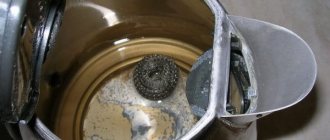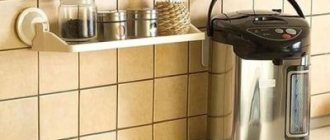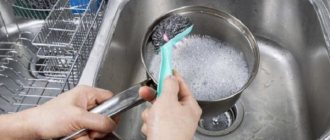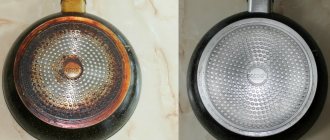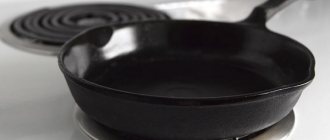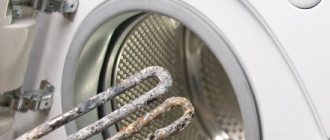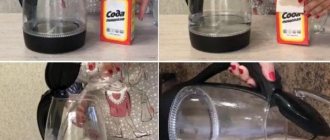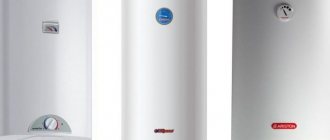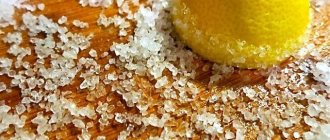Homemade quick methods for removing stains and other stains
To remove old stains and even rust, it is not necessary to use aggressive chemicals. There are more conservative methods that will be safer. Their main advantage is their availability and the ability to use them independently at home. Let's take a closer look at some ways to clean fat.
Baking soda
Pan soot is easily washed off after using baking soda. The product is prepared according to a simple principle:
- If you buy a medium-sized package of soda, it is advisable to check the composition for the absence of impurities.
- A third of the package should be placed in five liters of water.
- Damaged dishes should be boiled in the prepared mixture. However, the time may vary and depend on the level of pollution. For lightly soiled dishes from 10 to 30 minutes, and stubborn and old grease stains - up to two hours.
PVA glue and some lye soap
There is glue in every apartment and it can be used not only for office purposes. The method of using such a component in a cleaning product is used for all types of dishes, regardless of the characteristics of the surface. Such ingredients can cope with both light stains and old stains.
The use of glue and soap is not complicated and looks like this:
- Prepare the ingredients for the solution.
- Mix one and a half bars of grated soap (preferably ordinary laundry soap, which is sold in all supermarkets at a low price and even in pharmacies) with two tablespoons of PVA glue.
- Add five liters of water to the ingredients. For greater effect, use filtered.
- Boil over medium heat for 20 minutes to one and a half hours. This will be enough to remove medium stains.
- After the boiled mixture has cooled, wipe the dishes with a clean sponge and rinse thoroughly under running water.
Baking soda in combination with silicate glue
Another effective “pair” that is not inferior in effectiveness to previous methods. The frequency of using this method is due to the fact that it cleans the inside and outside of the dishes as much as possible. The cleaning process is as follows:
- Fill a large container with water. These can be basins or buckets. The main thing is not soaking in plastic products.
- Pour one and a half packages of soda into water and add a medium tube of silicate glue. The main thing is not to overdo it with the last component, so as not to achieve the opposite effect from such a kitchen procedure.
- The solution must be boiled and all damaged dishes must be added. Plates, pots and other kitchen utensils must be immersed completely, without open areas.
- The “bath” lasts for twenty minutes. Next, drain the solution and rinse the dishes under running water.
- If necessary, you can wash with detergent or continue soaking with updated doses of baking soda and silicate glue.
Sour apples and rhubarb
Housewives know how to make apple pie and rhubarb pies. But they rarely think about using this “couple” for other purposes. Their proper preparation can serve as an excellent remedy for getting rid of the ever-present problem of grease on dishes.
The acid in these products is beneficial for the body, but harmful to scale. Therefore, exposure to high temperature can affect fats and dissolve them. It is enough to grate the two components, add water in a damaged container and boil. The duration of the procedure varies from five to ten minutes depending on the amount of contamination.
If you need to wash the outer part, you can do the following:
- Grate the apple and rhubarb. Moisten with water and leave for a couple of minutes.
- Strain the contents, leaving only the water.
- These acids can be moistened with sponges or added to any chemical product.
- It should be used regularly to completely remove fat.
A few more tips
The outside surface of the kettle must be cleaned regularly; many have learned in practice that it is much more difficult to deal with old dirt.
- It is safer to use improvised means. Leave household chemicals for cleaning heavily soiled surfaces.
- When using special chemicals, you must adhere to the specified dosage, and do not forget about protection in the form of gloves and a respirator.
- If anyone in the family has allergies, you should not use chemicals in the kitchen.
These methods of cleaning the kettle from grease contaminants will allow you to keep it perfectly clean and enjoy the taste of aromatic tea with your family and friends.
Ways to remove burnt sugar from a pan
There are many ways to clean burnt sugar, even if several days have passed since the contamination occurred. You can choose household chemicals or folk remedies taking into account the coating of the pan.
Cleaning with household chemicals
Household products contain surfactants - substances that reduce the adhesion of burnt sugar to the surface of kitchen utensils. The easiest way is laundry soap.
Some surfactant products, including soap, contain abrasive particles, so you need to choose wisely.
Laundry soap will help clean the pan from sugar deposits.
Cleaning with laundry soap is quite easy:
- Soften some of the soap in warm water;
- Add the soaked mass to the pan, applying it to the places where soot has formed;
- Wait until the soap mass hardens;
- Fill the pan with hot water and boil this mixture for 60 minutes;
- Cool and drain, scrubbing off any remaining residue with a soft sponge.
The carbon deposits will come off under the influence of soap, but the surface of the pan will remain undamaged.
One effective method for cleaning kitchen utensils is baking soda.
Acid cleaning
Acid perfectly helps remove burnt sugar from the sides and bottom of the pan.
Fill the pan with water, add two tablespoons of citric acid inside (or more if the internal volume of the dish is large). Leave for at least 5 hours so that the acid has time to dissolve the sugar particles.
In addition to citric acid, you can use natural lemon juice or 9% table vinegar.
The method is suitable for any type of surface, since it cleans much softer than any other means, and the acidity is not enough to corrode the coating.
Salt should not be used on stainless steel utensils,
Cleaning with salt
Regular salt is also an excellent remedy. Pour cold water into the pan and leave for 60 minutes - during this time the sugar soot will have time to soak. Afterwards, drain the water and cover the burnt areas with salt. Leave for 2-3 hours, then go over with a regular soft sponge and rinse with warm water.
You should not clean stainless steel cookware with salt as it will cause dark stains.
Cleaning with soda
You can clean the pan using baking soda paste. Soak the required amount of baking soda with soapy water and then apply it to the burnt parts of the dishes. Afterwards, rinse with warm water. Another way: boil in a saucepan in a water-salt solution for 10 minutes.
Activated carbon is a safe way to clean kitchenware.
Activated carbon cleaning
Activated carbon is a fairly safe method, suitable for dishes made of any materials. The tablets must be crushed to a powder, then diluted with clean warm water. Apply the creamy mixture onto the burnt sugar caramel. After 20 minutes, the dirt will be easily washed off.
Cleaning with soda, laundry soap and silicate glue
Grate the laundry soap, add silicate glue (no more than 100 grams) to the mixture and add three liters of water.
The mixture is poured into the burnt pan, after which it needs to be boiled over low heat for 30 minutes. The caramel will soften and the residue can be washed off with a simple sponge.
Teflon coating cannot be cleaned in this way.
You can also use toothpowder to clean kitchen utensils.
Cleaning with tooth powder
Tooth powder can even cope with sugar plaque. First you need to prepare the mixture: dilute the powder to a paste, apply it to the burnt areas and leave for 12 hours. Afterwards, wash off with soapy water and rinse with clean water.
Cleaning with dry mustard and coffee
Mustard powder and coffee similarly need to be softened to a mushy state using plain water. Then apply to the burnt areas and leave for several hours. Wash off the softened dirt with water. Or use coffee grounds for the same purpose.
Using coffee grounds to clean pots.
Cleaning the electric kettle
It is recommended to clean the inside of an electric kettle from rust with food acids - citric or acetic. They are safe for health, and you don’t have to worry about residues going into your drinking water. In addition, food acids will gently remove rusty deposits without damaging the material. A special product will help against severe stains.
Lemon acid
Cleaning is very easy:
- Fill the electric kettle with water to the maximum level.
- Pour in a sachet (10–15 g) of citric acid.
- Turn on and boil.
- Wait a while and boil again.
- Leave the device for 10–15 minutes.
- Pour out the lemon water and wipe the inside with a sponge.
- Rinse under the tap, draw clean water.
- Boil and drain the boiling water.
It is important to be careful: after boiling, the metal parts will be hot. It is recommended to wait until the inner walls and heating element have cooled down. Only then can you wipe with a sponge
For protection, wear rubber gloves. The sponge will quickly turn orange, so it must be washed or replaced frequently.
Only then can you wipe with a sponge. For protection, wear rubber gloves. The sponge will quickly turn orange, so it must be washed or replaced frequently.
Instead of powder, you can wash the kettle with fresh lemon. The acid in it is not so concentrated, so the juice is suitable for light rust. The cleaning principle is the same: put chopped lemon (1-4 slices) into water and boil it several times. First, you can rub the parts of the kettle with lemon, let it sit for two minutes, and only then add water and boil with the same slices.
Vinegar and soda
Plastic can be cleaned with carbon dioxide. It is formed as a result of the reaction between a vinegar solution and baking soda. How to do:
- Fill the electric kettle three-quarters full with water.
- Add vinegar solution to the maximum level.
- Add a tablespoon of baking soda.
- Wait for the reaction to complete and boil the liquid.
- Leave until cool.
- Drain and rinse under the tap.
If the rust has a brown tint, you can try cleaning the surface with vinegar and water. The method is suitable for metal, glass and plastic teapots. How to use:
- Pour 2 glasses of water inside.
- Boil and pour in half a glass of 9% vinegar solution.
- Leave for an hour.
- Drain and boil clean water several times.
You should periodically check how the cleaning process is progressing. If rust and scale have swelled but not come off, they can be helped with a sponge or an old toothbrush.
Bagi Kumkumit
If you cannot remove the rust with folk remedies, it is recommended to use the Kumkumit Bagi cleaning liquid. In addition to rust, it will get rid of old limescale deposits. Suitable for metal and plastic electric kettles. Contains citric acid. Available in 350 ml bottles. Costs 150–250 rubles.
How to clean a kettle from rust:
- Distribute 50–100 ml of liquid evenly over the surface.
- Leave for 3-5 minutes.
- Pour 500 ml of water inside and boil.
- Rinse thoroughly under the tap, add clean water and boil again.
There is another way to use it. It is necessary to pour 3/4 of water into the kettle and boil. Then pour in 100 ml of cleaning liquid and leave for 15–20 minutes. Then rinse under running water.
How to clean a stainless steel kettle from carbon deposits
While it is relatively easy to clean the outside of a stainless steel kettle from grease, cleaning off the burnt marks is much more difficult. The most effective method is boiling with the addition of various cleaning and acid-containing products.
Activated carbon
You will need one package (10 tablets of activated carbon).
Crush them into powder with a spoon or rolling pin. Lightly moisten the kettle with hot water or pour boiling water over it. Apply the resulting black powder and leave for 40–60 minutes. After the specified period of time, clean with a damp sponge and rinse with water.
Boiling in soda solution
To clean a heavily soiled stainless steel kettle, it is often not enough to simply polish it with a sponge. Soaking in a composition of several components allows you to quickly and effortlessly clean the surface from carbon deposits.
How to cook:
- Find a spacious iron pan where you can put the kettle.
- Prepare soda ash (not baking soda, but for washing and laundry - usually the information is on the packaging), laundry soap and one sour apple.
- Pour water into a saucepan and add soda at the rate of 2 teaspoons per 1 liter of water, bring to a boil.
- Grate laundry soap (100 grams per 5 liters) on a fine grater, and 1 apple on a coarse grater.
- Place the ingredients in a saucepan and mix everything.
- Place a kettle into the boiled solution, reduce the burner power and boil for 30 minutes to 1.5 hours. From time to time you can try to clean the contaminated surface with a wooden spatula to see if the carbon deposits are coming off well.
- When the layer of fat and burnt material softens, remove the kettle, clean it with a sponge, rinse with water and wipe.
Ammonia
When using this product, it is advisable to wear a respirator or not bring the container close to your nose. You can clean not only stainless steel surfaces with ammonia, but also the body of the electric kettle in order to add shine and remove dirt.
Remove a thick layer of carbon as follows:
- grease a dry stainless steel kettle generously with ammonia (usually 50–100 ml is required);
- put the product in a plastic bag, put 1 or 2 more bags on top, tie tightly to prevent the ammonia from evaporating;
- leave for 10–12 hours;
- remove from the bag, wash the kettle with a sponge or clean with force and dry.
The main disadvantage of this method is the strong smell, but the carbon deposits come off perfectly on its own and almost no effort is required.
Chlorine-free bleach
This method is based on the use of industrial cleaning products. In the store you need to buy any powdered bleach without chlorine, for example “Bos Plus”, its price is about 100 rubles.
Prepare the current solution:
- place the kettle in a large saucepan;
- Before boiling, add 5 grams of bleach to the water per 5 liters;
- boil the solution for 30–60 minutes;
- take out the kettle, put it in a basin with warm water and clean off any remaining carbon deposits, rub hard-to-reach places with a toothbrush.
How to remove scale?
If hard water flows in the house, then scale will certainly form on the walls of the boiling water container. To reduce its amount, you need to use filters or order purified water. You can clean the kettle using the following methods:
Vinegar. Vinegar is poured into the contaminated container. Water is added in the same quantity. The water is brought to a boil, after which the burner is turned off
If the housewife decides to boil the kettle longer, it is important to open the windows and leave the kitchen, since the vinegar fumes are quite harmful. After a few hours, the limescale deposits can be carefully removed with a brush or stiff sponge. Citric acid is completely harmless, so many people prefer to use it
You need to fill the kettle with water to the top and add a couple of packets of acid into it. Turn on the heat and simmer until the plaque begins to come off. Turn off the burner and leave until completely cool. The scale can then be easily removed.
Cleaning a stainless steel item at home is quite easy. After cleaning is completed, you need to polish the item with a soft cloth for a shine.
Cleaning without chemicals
Grease splashes can be easily removed with regular baking soda. Just pour it on a damp kitchen sponge and rub the outside surface
This must be done carefully; no special effort is required.
Be especially careful when cleaning the nickel plating; strong friction may cause scratches.
Baking soda can be replaced with a milder product, such as toothpaste. In special cases, old dirt can be cleaned with a solution made from equal parts of baking soda, salt and vinegar. Mix them one teaspoon at a time, rub the dried dirt and rinse thoroughly.
If the kettle is made of aluminum
It is easy to clean such dishes using activated carbon purchased at a pharmacy.
- crush 10–15 tablets of activated carbon into powder;
- wet the walls of the dish and apply the powder evenly;
- leave for an hour, wipe and rinse with water.
Cleaning a stainless steel kettle
On stainless steel teapots all the slightest dirt is visible. You can clean them using simple available means and methods.
Method 1. Allows you to remove stains and grease using baking soda:
the dishes are heated; put on the table; apply soda to a damp sponge; wipe off dirt with care; rinse first with warm, then with cold water.
Preheating allows you to quickly remove dirt from the surface of the dishes.
Method 2. Boiling in soda solution:
- Take warm water into a bucket or basin, dissolve soda in it, 1 tablespoon per liter of water;
- put the container to heat, lower a kettle or other utensils into it;
- after 30 minutes of boiling, turn off and leave until completely cooled;
- Remains of dirt are removed with a sponge;
- The dishes are thoroughly washed in running water and wiped dry.
Method 3. Boiling in a solution of soda and vinegar allows you to remove fat in less time:
- prepare a solution in a prepared container by adding three tablespoons of baking soda and table vinegar to heated water;
- a kettle is lowered into the solution and heated to a boil;
- boil for no more than 4–5 minutes, then leave to cool;
- rinse with water and dry with a towel.
It is important that the dishes are completely covered with the solution. Method 4
Treatment with toothpaste allows you to quickly and effortlessly wash the kettle of any dirt:
Method 4. Treatment with toothpaste allows you to quickly and effortlessly wash the kettle of any dirt:
just squeeze the paste from the tube onto the hard side of a sponge or onto an unnecessary brush; rub the outside with care, then rinse first in warm, then in cold water; Finish cleaning by buffing the surface to a shine with a flannel cloth or napkin.
